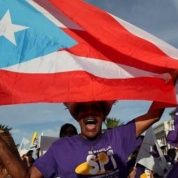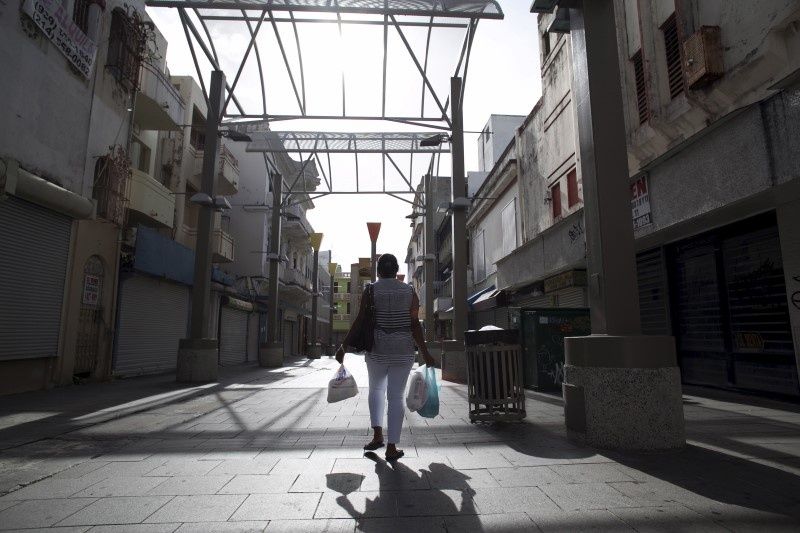Puerto Rico looks set to miss a new deadline on payments regarding the island's US$72 billion debt. Despite the measures taken by local authorities, many are asking: who should really pay the staggering debt?

RELATED:
Uncertainty Looms Over Puerto Rico, Faces Largest Debt Default
Local politicians? Bankers? Puerto Ricans in general? Or, a s Puerto Rico's Representative Pedro Pierluisi has said, should the United States pay? The complex issue has led to speculation and confusion among observers.
But a closer look at the historic relationship between the island and the U.S. mainland, its economic performance and its most recent crisis, may help in explaining who should really help Puerto Rico pay its astronomical debt.
After 115 years under U.S. control, some are calling for the island's independence as the only way out. Others believe the economy should default.
However, the economic crisis at hand has been produced not only by the U.S. government, but also due to structural and external pressures which have been dragging on for almost a decade.
A Laboratory for the 'Free Market'
The citizens of Puerto Rico were officially recognized as U.S. citizens in 1917. However, contrary to the common belief that the island is another state within the Union, Puerto Ricans cannot vote in United States elections while living on the island.

A woman walks through a commercial area with stores either closed or offered for sale in Puerto Rico | Photo: Reuters
The special status which the nation holds—"commonwealth"—is regarded by many as a colonial arrangement, where Puerto Ricans are subject to U.S. Federal Law but have no say in the legislative process which creates these laws.
This means that the island lacks local autonomy and decisions taken by U.S. federal authorities are legally binding on Puerto Rican authorities.
Since the late 1940s, the U.S. government has promoted investment in the island through an alluring tax exemption program. Despite being partially halted during the 1990s, causing many companies to leave, the tax cuts were reintroduced in 2008.
In 2013 the local government passed laws allowing new residents to pay zero taxes on capital gains and zero taxes on income derived from local businesses in an effort to continue appealing to wealthy investors.
New taxes would largely affect middle and lower classes, without tapping into the wealth of those benefiting from decades of tax exemptions.
Despite these incentives, Puerto Rico has seen little wealth distributed to the general population. The island has the second highest inequality rate when compared to the other 50 states within the U.S.
Furthermore, Section 936 of the IRS tax code stipulates that profits made on the island must be transferred back to the U.S. mainland; a measure designed to stimulate job creation, instead this has enabled mass cash outflow.
This has led to an economic model based on dependence on the U.S. that has enabled corporate exploitation, built over the years into what is referred to as Operation Bootstrap.
Through a series of measures and federal laws, Washington promoted the decline of Puerto Rico's sugar industry and agriculture, paving the way for U.S. capital to invest in consumer goods industries and—most recently—services.
The idea behind the architecture of the so-called Operation Bootstrap was to counter Cuban influence in the Caribbean by maintaining a stable and prosperous Puerto Rico as an example of the benefits of following U.S.-style free market policies.
Today, small scale producers and local shop owners are struggling to compete with U.S. companies and chain stores. Local agriculture is virtually non-existent, and most of the arable land is owned by corporations.
“There's more Walmarts and chain stores per capita in Puerto Rico than any place else,” explained Puerto Rican activist David Galarza during an interview in New York's WBAI radio in 2015.
This partially explains why 90 percent of the island's exports are destined for the U.S., most of them manufactured goods sold by U.S. corporations.
The system imposed by Operation Bootstrap has been largely reflected in the current quagmire; while Puerto Rico's economy has been contracting since 2006, tax evasion is widespread and—due to its political status—federal laws prevent the island's government from requesting loans from international institutions.
Since 2000, Puerto Rico's debt has been growing at a rate that outpaces its GDP growth, meaning that soon the country will have more debt than income.
"Puerto Rico’s economy is clearly unsustainable, barely able to generate enough capital to service its debt,” academic Ed Morales explained in his essay "Puerto Rico’s Dance With Debt."
A Disastrous Scenario
Making matters worse, in July 2016 the U.S. Court of Appeals in Boston ruled that Puerto Rico cannot restructure its own debt. Given that the island is not a state, it cannot file for bankruptcy, as cities such as Detroit have done, to get federal relief.
The island's Governor, Alejandro Garcia Padilla, shocked the world when in 2015 he publicly acknowledged that the debt held by Puerto Rico is unpayable.
Public spending is an important issue in Puerto Rico. Over a third of the island's population receives food stamps and, according to Galarza, between 60 and 70 percent rely on Medicare or other welfare programs.
The current crisis has driven thousands out of the country, which in turn has generated a significant decline in the labor force. In 2014, Puerto Rico saw the biggest drop in its population since World War II.
RELATED:
7 Top Key Points to Help Understand Puerto Rico's Debt Crisis
Puerto Rico's labor force "is about 40 percent," compared to 60 percent in the U.S. mainland, according to former IMF economist Anne Krueger who was appointed by the local government to elaborate a report detailing the situation.
Some in the government have proposed measures to render labor policies more flexible through such methods as reducing salaries, eliminating the minimum wage, and modifying working ages.
Without the option of restructuring the debt, the local government is trying to convince creditors to allow smaller payments in a wider time frame.
Some economists are arguing that the local government should tackle tax evasion and increase taxes. However, the island's many tax exemptions—some through federal laws—that benefit investors and U.S. corporations make it very difficult for the local authorities to tax the wealthiest.
In fact, tax revenues have remained stalled over the past 15 years. This means that new taxes would largely affect middle and lower classes, without tapping into the wealth of those benefiting from decades of tax exemptions.
The somber scenario leaves little options for the Puerto Rican government to solve the crisis on its own, and will require external intervention.
As a report by activist group Hedge Clippers shows, hedge funds could own up to 50 percent of the island's debt, which gives them significant leverage when it comes to negotiating.
“The basic idea is to demand that wages go down in Puerto Rico, to demand that taxes go up, to demand that utility rates, water rates, go up, and that all that money be shoveled straight to the hedge fund millionaires,” says Michael Kink who heads Hedge Clippers
If Washington fails to help the island, the local government would run out of cash. According to the CATO Institute, Puerto Rico’s constitution necessitates that the government repay its general-obligation bonds before even government workers receive their pay, making it likely that the government will sell public property.
“These banks and hedge funds have the people over a barrel; it's unconstitutional in Puerto Rico to default over a debt. And you can see a scenario where public utilities, public assets like water, even the tax receipts of the government could basically be impounded by these hedge fund guys...that seems to be what's gonna happen,” warned Kink in 2015.
Despite promises made by Governor Garcia, he has continued to favor privatizations and other austerity measures such as cutting pensions which have been applied by his predecessors in the recent past.
Even the debt restructuring terms demanded by local mainstream politicians include a set of policies which would mean further cuts in services and pensions.
Who Should Pay the Tab?
Responsibility for Puerto Rico's debt crisis cannot be equally shared. The island's crippled economy is a product of U.S. foreign policy—and this does not only include Operation Bootstrap.
With the approval of the Dominican Republic-Central America free trade agreement, or CAFTA-DR, the island has been forced to compete with its Caribbean neighbors which have much lower wages.
U.S. laws have also undermined Puerto Rico’s global competitiveness. For example, the Merchant Marine Act of 1920 prohibits non-American ships from carrying goods between the island and the U.S. mainland, which has raised costs in transportation and created difficulties in trade with other countries.
The U.S. federal budget allocated to the island differs greatly when compared to similarly sized states, and some social welfare programs exclude the island altogether.
However, local governors are also responsible for the debt crisis, taking out billions of dollars in loans even when the economy was in a healthier position.
It should not be the Puerto Rican people paying the debt, but the large U.S. moguls and corporations that have been enjoying the island's tax-haven scheme, together with the local elite.
Furthermore, as in many recent crises, hedge funds play a larger role than is normally acknowledged; irresponsible borrowing has been fueled by irresponsible lending.
Vulture funds have rushed to the island to buy risky bonds in a scenario recalling Argentina, 2001—or more recently, Greece.
The scheme consists in opportunistic investors—who act through hedge funds, often dubbed “vulture funds”—taking advantage of an inevitable economic crisis in order to, in the aftermath, gain returns on the amount of money originally invested.
“These guys (vulture funds) have bought up the debt in an effort to get it paid to get huge, huge returns. As an example, Paul Singer, one of the hedge fund managers that's in this game, when he pulled a similar stunt with Argentina they made 13,000 percent profit on the deal. Not double your money, not triple your money, but 15 times (return in) your money,” explains Kink.
As the report by Hedge Clippers documents, many of the hedge funds that hold Puerto Rico's debt were involved in the Argentine and Greek crises.
Furthermore, these investors have powerful allies inside the U.S. Congress and are significant financiers of both the Republican and Democratic parties.
Given the current situation, it should not be the Puerto Rican people paying the debt, but the large U.S. moguls and corporations that have been enjoying the island's tax-haven scheme, together with the local elite , who have failed to manage the debt and continue to insist on applying austerity measures.
The ideal scenario would resemble that of post-crisis Argentina, where the Kirchner administration (2003-2007) implemented a set of policies to reform the economy such as implementing financial controls, recovering state-owned assets and boosting local industry. However, none of the major parties in Puerto Rico have suggested such a strategy.
It is now up to Capitol Hill to show if it will back the island against the vulture funds. A solution to the crisis could amount to potential political gains for the Democrats or the Republicans, since both are trying to attract the Latino vote (over 17 percent of the population) in the upcoming presidential elections.
Even though Puerto Ricans within the island's territory cannot vote, assistance to the island would certainly have an impact on Hispanic constituents, as well as on the 5 million Puerto Ricans living on U.S. soil.
UPDATE:
This story was originally published in 2015 and has been edited to reflect the most recent events.